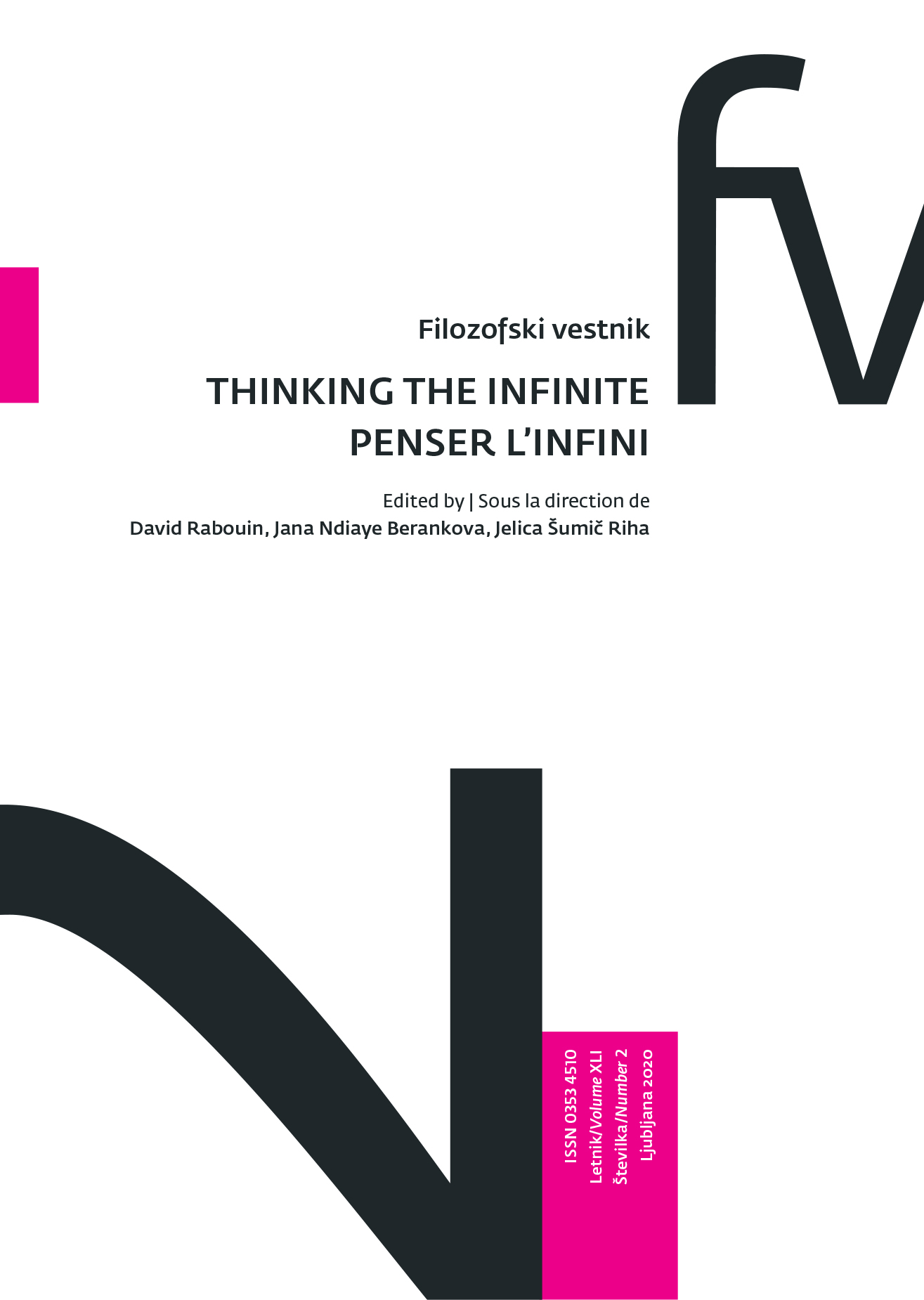Neskončnost med dvema koncema: Dvojnosti, algebrski univerzumi, skice, diagrami
DOI:
https://doi.org/10.3986/fv.41.2.09Ključne besede:
algebrski univerzum, bit, Cantor, kategorija, diagram, dvojnost, forma, ontologija, fenomenologija, kardinalnost, meja, oblika, skica, strukturalizem, ZenonPovzetek
Avtor tega prispevka prepozna v Badioujevi obravnavi neskončnega na podlagi teorije množic odločno strukturalističen pristop. Strukturalizem ni tisto, kar pogosto kritizirajo, se pravi, način, kako uporabiti matematične teorije na bolj ali manj filozofske problme. Prej gre za stališče v samem matematičnem mišljenju, kar je razvidno iz reševanja matematičnih problemov s strukturiranimi podatki, in to ne oziraje se na vprašanja utemeljitve. Tako stališče podpira matematična teorija kategorij, kar omogoča osredinjenje na funkcioniranje matematičnega dela. Na podlagi take perspektive je mogoče mišljenje neskončnosti dojeti kot mišljenje samega matematičnega dela, ki sestoji iz razgrinjanja dvojnosti, začenši z vprašanjem razločenega in kontinuiranega ter Zenonovimi paradoksi. Avtor pri tem zagovarja stališče, da je v intervalu vsake dvojnosti – »med dvema koncema«, kot je zapisano v našem naslovu – mogoče videti neskončnost na delu. Temu stališču je mogoče nasproti postaviti predstavo, da matematika proizvaja teorije neskončnosti, naj gre za infinitezimalni račun ali teorijo množic, kar je seveda res. Toda te teorije nam zgolj omogočajo razumeti vprašanje neskončnosti, če se vanje umestimo, če jih prakticiramo. Edino v tem primeru je dejansko matematična dejavnost tista, ki reprezentira neskončnost, kot jo nato prezentira mišljenju. V tem prispevku bi radi pokazali, da orodja, kot so algebrski univerzumi, skice, diagrami omogočajo, da se ognemo »računanju«, ki je vedno povezano s kardinali in ordinali, oziroma da opišemo strukture in rokovanje z njimi, neskončno in nedoločno delo lepljenja podatkov, delo, ki na ravni objektov konstituirajo aktualno neskončnost, pri čemer je teorija struktur kalkulacija te neskončnosit. Na podlagi teh tehničnih podrobnost avtor na koncu predlaga Badiouju, da ontologijo obravnava tako, da se vrne k fenomenologiji njegovih »logik svetov«, s čimer bi se vprašanje biti premestilo na področje svetov, kjer so resnice proizvedene, se pravi tam, kjer se postavlja vprašanje neskončnosti.
Prenosi
Literatura
Badiou, Alain, La République de Platon, Fayard, Paris 2012
— Le Séminaire. Parménide. L’être 1 — Figure ontologique. 1985-1986, Fayard, Paris 2014
— L’Être et l’événement, Seuil, Paris 1988
— L’immanence des vérités. L’Être et l’événement, 3, Fayard, Paris 2018
— Logiques des mondes. L’Être et l’événement, 2, Seuil, Paris 2006
Dehornoy, Patrick, La théorie des ensembles : introduction à une théorie de l'infini et des
grands cardinaux, Calvage et Mounet, Paris 2017
Foreman, Matt et Akihiro Kanamori (dirs.), Handbook of Set Theory, Springer, Berlin et
Heidelberg 2010
Goldblatt, Robert, Topoï: The Categorical Analysis of Logic, Elsevier, Amsterdam 1984
Jech, Thomas, Set Theory, Springer, Berlin Heidelberg 1997
Kanamori, Akihiro, The Higher Infinite, Springer, Berlin Heidelberg 1994
Lacan, Jacques, «Acte de Fondation » [1964], repris dans Autres écrits, Seuil, Paris 2001
Guitart, René, textes disponibles sur : http ://rene.guitart.pagesperso-orange.fr.
Rabouin, David, Oliver Feltham et Lissa Lincoln (dirs.), Autour de « Logiques des mondes »
d’Alain Badiou, Éditions des archives contemporaines, Paris 2011
Prenosi
Objavljeno
Kako citirati
Številka
Rubrike
Licenca
Avtorji jamčijo, da je delo njihova avtorska stvaritev, da v njem niso kršene avtorske pravice tretjih oseb ali kake druge pravice. V primeru zahtevkov tretjih oseb se avtorji zavezujejo, da bodo varovali interese založnika ter da bodo povrnili morebitno škodo.
Podrobneje v rubriki: Prispevki





